|
We have seen in the earlier
chapters that Alberta was in the possession of several tribes of Indians
when the first white travellers reached its borders. The various tribes
represented branches of the three great Indian families or linguistic
groups as follows:
Algonquian, western
division, comprising Blackfeet (Siksika), Bloods, (Kainah) , Peigans.
Algonquian, northern division, Crees, Plain Wood and Swampy.
Athapascan, comprising Chipewyans, Beavers, Yellowknives, Dogribs and
Hares. The Sarcees (Sarsi) who belong to this stock are politically
allied to the Blackfoot Confederacy.
Siouan, comprising Assiniboines or Stonies.
Other groups represented
in the early history of the province are the Kutenai, the Iroquois, Gros
Ventres or Atsina. The Iroquois were brought to the North Saskatchwan
River by the North West Company about 1800.
The Blackfeet were the
advance guard of the Algonquian emigration to the west. Mackenzie
mentions them and says that about 1790 they occupied territory between
the south and north Saskatchewan Rivers and were in slow migration
toward the northwest encroaching on the Athapascans. This migration was
deflected southward by the Crees, who having been joined with the
Assiniboines, sought the plains westward to hunt the buffalo, hence the
unrelenting hostility between the two confederacies of the west. The
pressure of the Crees upon the Blackfeet drove the latter finally to the
country south of the south branch of the Saskatchewan. Until they were
placed on Reserves in 1877 they roamed from the Cypress Hills to the
Rocky Mountains and southward to the Missouri River. The Crees pushed
northward as well as southward until they came in contact with the
Chipewyans and Slaves along the Churchill River and on the shores of
Lake Athabasca. After they obtained firearms from the fur traders they
were able to drive these tribes from their hunting and fishing grounds,
but were forced back again, when the Chipewyans succeeded in securing
arms. The Blackfeet quickly adapted themselves from the sedentary life
of their ancestors to the roving life of buffalo hunters. Once
established on the plains of Southern Alberta they held it against
invasion from every side, from the Crows, Flatheads and Kutenai of
Montana and Washington, from the Assiniboines of the Cypress Hills and
Wood Mountains and from the Crees of the north. In their raids to the
south they secured horses and became famous for great herds of fine
horses. The horse made them formidable in war and successful in the
chase. They dwelt in tepees shifting periodically from place to Place.
They gave little attention to agriculture except the cultivation of P.
species of tobacco and they gathered camas roots in the foothills. The
three main divisions lived independently of each other. Each had its own
head chief, council, and sun dance. They worshipped the sun and a
supernatural being known as Napi or Old Man, a sort of secondary
creator. They laid their dead in trees or in tepees on some prominent
hill. They were restless, aggressive, and predatory people and were
constantly at war with all their neighbors. Their general attitude
towards the Hudson's Bay Company was always one of doubtful friendship.
The Crees were divided
into Wood, Plain and Swampy Crees according to the nature of the
locality in which they lived. The Plain and Wood Crees lived in Alberta,
but the Swampy Crees lived east of Lake Winnipeg in the marshy regions
around Hudson's Bay. The Crees were always closely associated with the
Hudson's Bay Company and regular visitors to the Company's posts. They
were employed as hunters, canoe men and guides. The Crees worshipped a
being akin to the Old Man of the Blackfeet, called Wisukatcak. They
buried their dead in shallow graves, covering the same with stones or
earth. If the deceased were a warrior or medicine man of renown, his
body was laid on a scaffold.
The Chipewyans, Slaves,
Beavers, the Sarsi and other tribes of the Athapascan family have shown
little coherence and less power of maintaining their own culture than
either the Crees or Blackfeet. They have assimilated the customs and
arts of all the surrounding tribes.
From the advent of the
white men, the Indian population steadily declined. Mackenzie estimated
the Blackfeet in 1790 at 2,300 warriors or 9,000 souls. The smallpox
scourge killed off large numbers in 1780, 1838, 1845, 1858 and 1859.
Many died of measles in 1864. Smallpox raged among them again in 1870.
Added to these calamities were the ravages of intemperance caused by
American traders. To the American trader the only good Indian was a dead
Indian and consequently the murderous proclivities of these outlaws were
responsible for the death of many of the Indian population, e. g., in
1873 American outlaws shot 23 Assiniboines near the Cypress hills as a
pastime on the pretext of horse stealing. The Crees were estimated at
about 15,000 when the fur traders entered the west about 1775. They have
suffered terribly from smallpox especially in the outbreak of 1870.
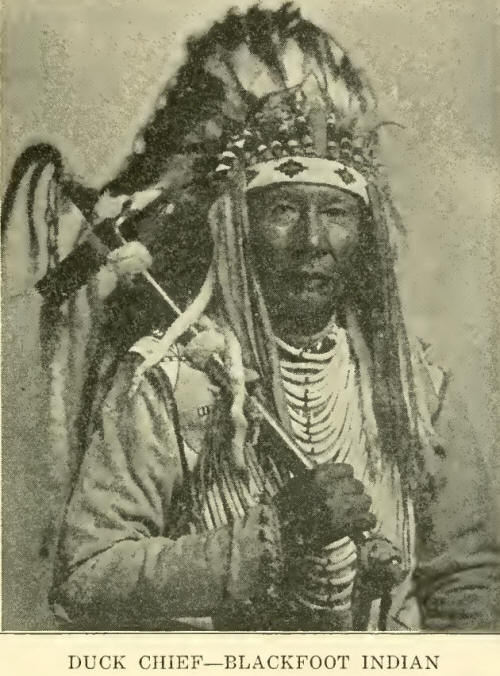
When Canada took over the
Hudson's Bay territory in 1870, one of the conditions of the surrender
was that the Indian population would be justly and humanely dealt with.
The people of Canada have sincerely and generously kept this pact. The
Indian title to the lands of the plains and forests was recognized.
Treaties were made with the various tribes, reserves were given for
permanent residence and in lieu of the hunting privileges, food and
money have been regularly supplied. Many of the Indians, of course, are
self sustaining and have acquired the arts of agriculture and civilized
life. As far as Alberta is concerned, the first Treaty made with the
Indians was signed in 1876 at Fort Carlton and Fort Pitt. This Treaty
included the Indians of central Alberta, the Crees, Iroquois,
Assiniboines and the few Chipewyans at Cold Lake. Treaty No. 7, was
signed at Blackfoot Crossing in 1877. It included the three tribes of
the Blackleet, the Sarsi and the Stonies. The last Treaty was signed
with the Indians of Northern Alberta in 1899 and included the Crees and
Beavers of the Peace River District.
It is difficult to
ascertain the names of the first actual white settlers, outside of the
fur traders and missionaries, who came to the Province. Some of the
first settlers, like James Gibbons, of Edmonton, are still alive. Tom
Clover, accompanied by two men, Love and McFarlane, and others in the
same party, came to the Province in 1864, and discovered placer gold in
the North Saskatchewan River a few miles below Edmonton. The place has
ever since been known as Clover Bar. Gold had been observed by Dr.
Hector in 1858. That same autumn a party of miners travelled from Idaho
via the Columbia Valley, Simpson Pass, to the Bow River Valley, along
the present Banff-Windermere Highway to the open plains where they found
a great Indian trail, and following it arrived at Rocky Mountain House.
Of this party of fifteen, only James Gibbons and Sam Livingstone
permanently settled in the country. Livingstone finally settled in
Calgary. Gibbons invented what is still known along the Saskatchewan and
rivers of the North, as "The Grizzly," a simple apparatus for separating
gold from the gravel of the river. By 1868 there were about fifty gold
workers oil North Saskatchewan.
The extinguishment of the
Indian title was the prelude to railroad construction, immigration and
settlement. At the time of the transfer of the North-West to Canada,
there were very few white settlers in Alberta. These were generally
found close to the Hudson's Bay posts at Edmonton, Lac Ste. Anne and
Chipewyan. They were mostly men who had retired from the Hudson's Bay
service to engage in free trade or in agriculture. There were also
settlements at St. Albert and Victoria, but the inhabitants were mostly
half-breeds. A number of Manitoba half-breeds, dissatisfied with the
turn of events in that Province after Riel's first rebellion, moved
Westward. A few of the half-breed families on the Red River reached
Alberta and settled oil Battle River, in what is known today as the
Camrose District. The Laboucan and the Selvais settlements on the Battle
River were founded in this way. There were also half-breed settlements
at Buffalo Lake, St. Albert, Beaver Lake, Frog Lake, Lac La Biche and
White Fish Lake.
As soon as the survey for
the C. P. R. was begun, settlers began to find their way along the
projected route. The first to arrive in Alberta settled in the Edmonton
District in the expectation that the railway was to pass through or near
the old trading post. In 1878 a number of settlers arrived at St. Albert
from Peace River. Some of them, like the late William Gust of St.
Albert, had spent several years washing gold from the gravels of the
Peace River. The route of the C. P. R. was changed to cross the Rocky
Mountains through the Kicking Horse Pass instead of through the
Ye!lowhead Pass. Consequently settlement began to follow the new line.
Medicine Hat, Silver City and Calgary began to grow in the early 'SOS.
Silver City was so called on account of the supposed deposits of silver
in the vicinity of Castle Mountain and rapidly surpassed Calgary. It
grew in a few months into a city peopled with speculators and with
prospectors from every mining camp from California to Alaska. Today the
traveller on the Imperial Limited may have pointed out to him a scar or
two on the mountain side or a few piles of weatherbeaten rubble that
mark the location of the shadow city of those romantic days.
Shortly after the Mounted
Police established Fort Macleod, farmers and ranchers began to take up
land land in the vicinity of the post. The discovery of coal on the
Belly River marked the beginning of Lethbridge. As soon as the C. P. R.
was completed as far as Calgary, the trails to Edmonton and Macleod were
improved and year by year the land along the trails was taken up and
small settlements founded at various points. The stopping places formed
centres around which the settlement thrived. Some of these places like
Red Deer Crossing, Battle River Crossing north of Calgary and 1-ugh
River, south of Calgary have grown into important points. With the
construction of the railway north and south of Calgary, the settlement
of the country became a reality. A steady stream of immigrants from
Manitoba, Eastern Canada, British Isles, the United States and Central
Europe set in and has continued ever since. In 1883 Calgary was a
settlement of 300 people. At Morleyville on the C. P. R. west of Calgary
there was a settlement of sixty people. On the trail from Calgary to
Macleod there were two small settlements, viz., High River with fifty
people and Willow Creek with twenty-five. Beyond Macleod at Pincher
Creek there was another important settlement of eighty people and
several ranches.
The first homestead
patent in the North West Territories was issued to Thomas McKay of
Prince Albert in April, 1883. On the completion of the C. P. R. north to
Prince Albert from Regina and from Calgary to Edmonton, the Land
Department of the railway company began an active campaign to attract
settlers to the North-West, from Dakota and Washington territory. One of
the first settlements in the country south of Lethbridge was that of
sixty Mormon families from Utah who settled at Lee's Creek in 1887 and
founded the Cardston district named after one of the principal settlers.
By 1891 this colony had increased to 1,000 souls owning 23,000 head of
cattle and 9,000 sheep. Since that time it has developed into one of the
most prosperous and Populous districts in Alberta. In 1887 the Canadian
Agricultural and Coal Co. of which Sir John Lister- Kaye was president,
established a number of large and well equipped ranches and farms along
the C. P. R. at Bantry, Namaka and Langdon.
After the rebellion of
1885 many settlers entered Alberta by way of Saskatoon and Battleford
taking up land in the Sturgeon Valley north of Edmonton in 1886 and
1887. The next year a number of German families settled in the country
west of Red Deer in Township 36, Ranges 2 and 3 west of the 5th
Meridian, and in 1889 a large German immigration settled at Dunmore,
Gleichen, Seven Persons and Josephsburg. A year or two later over 200 of
these families moved northward and settled in the Stony Plain and Beaver
Hills districts west and east of Edmonton.
The years 1891 and '92
witnessed the real beginning of immigration to Alberta. Eighty-five
families of Austrians and Germans settled in the Stony Plain district. A
land office was opened in Red Deer and during that summer 406 homestead
entries were made. Forty-five families of Germans from Austria and
Russia settled at Fort Saskatchewan, sixty families of German Baptists
from South Russia settled southwest of Edmonton at Rabbit Hills and
thirty-five families of Germans settled at Wetaskiwin in the same year.
The next year thirty families of German Baptists from Russia settled in
two townships around Leduc.
The territory between
Edmonton and Calgary became the favorite area for settlement. In 1892,
3,134 settlers took up land along the Calgary and Edmonton Railway, 984
being from Eastern Canada, 620 from the United States and 220 from the
British Isles.
Through the efforts of
Bishop Grandin and Rev. Father Morin a large number of French Canadian
settlers were attracted to Northern Alberta in the early '90s. This was
part of a larger policy of the leaders of the French Canadians and the
Roman Catholic Church in the West to place a sufficient number of
settlers of that nationality and religion, in order to maintain the
minority rights respecting the French language and the Catholic
religion. Most of these settlers came from the old Province of Quebec. A
few were repatriated French-Canadians and their Sons from the United
States. The first party arrived at Calgary in March, 1891, destined for
St. Albert. They proceeded by sleighs to Red Deer, refusing to pay 840
per car to the Canadian Pacific Railway Company for transporting their
effects to the end of the steel, then at Red Deer. Here they were met by
numerous sleighs sent by their compatriots at St. Albert to fetch the
newcomers to their destination. By 1894 this was one of the most
populous colonies in Alberta, comprising over 1,000 souls between St.
Albert and Morinville. Other French-Canadian colonies were established
in these years at Stony Plain, Sandy Lake, Granger, Vegrevifle, St.
Pierre (now Villeneuve) and Beaumont, making in all about 2,000 of a
French-Canadian population at various points in Northern Alberta, owning
12,000 head of stock. Among these people were a number of settlers who
had come from Belgium.
In May, 1892, the Canadian Pacific Railway Company offered for sale the
odd numbered sections in the townships around Edmonton at prices from $3
to 815 per acre. This attracted a great many settlers. One firm in
Edmonton sold 10,000 acres in two weeks. Land offices were opened at
Calgary, Edmonton and Red Deer by the Company and many settlers were
brought in from the Palouse country in the State of Washington and from
Dakota, attracted by the prospects of mixed farming in the Edmonton
district. Swedish homesteaders settled around Red Deer and south of the
Battle River and many newcomers from Nebraska found homes in the
vicinity of Olds. In the same year about sixty families from Parry
Sound, Ontario, settled at Agricola and Partridge Hills and Edna in the
country east of Edmonton; other settlements of this time included the
Moravians at Bruderheim and Bruderfeldt and Scandinavians at Wetaskiwin
and Camrose.
One of the most important
of the foreign colonies to be established in Alberta consisted of a
large immigration from Russia, Galicia and Bukowina. The movement of
these people to Canada began in 1896. They settled in different parts of
the North West Territories, but a great many came to Alberta, settling
in a very fine agricultural district stretching from Fort Saskatchewan
to Vermilion. These settlers were devoted to agriculture and made
excellent progress in wealth and education. The census of 1916 showed
there were 14,733 classed as Russians, 11,372 as Austrians, 9,389 as
Galicians and 4,460 as Bukowinians in the Province of Alberta.
A most unique enterprise
in the colonization of Alberta was the migration of nearly 2,000 people
from England to the district now known as Lloydrninster between the
provinces of Alberta and Saskatchewan in 1903. This colony was organized
by Rev. I. M. Barr and was for many years known as the Barr colony and
also by the terms The All British Colony or sometimes The Britannia
Colony with the town of Lloydminster as its capital. When it arrived at
Halifax the colony comprised 1,964 souls. It took thirty cars to
transport their baggage. They proceeded by rail to Saskatoon. The long
trail overland to their homesteads was the most difficult and trying
part of their journey. Mr. Barr deserted the colony before it was
established but an able leader was found in the Rev. George E. Lloyd.
With a committee of twelve good men homesteads were allotted to the
heads of families and after many vicissitudes they succeeded in
establishing the colony. Though many of these people were ill adapted to
the pioneering life of the plains and though suffering attended their
efforts to build homes in a new land, they have succeeded in founding
one of the best settlements in Western Canada. They excel in the
production of grain and live stock, a tribute to the resources of the
district and to the adaptability and pluck of the British settler.
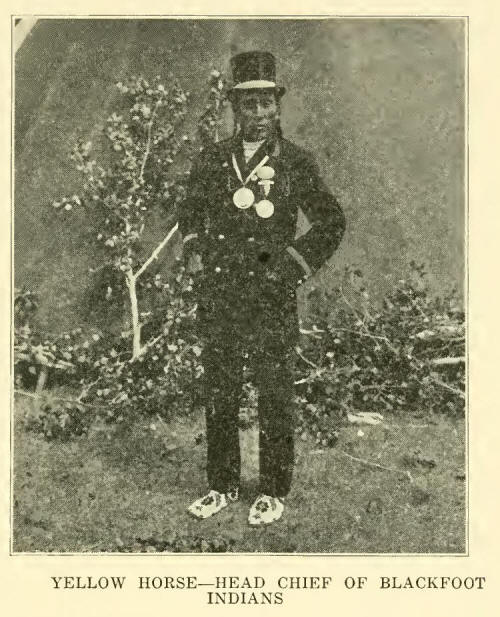
STATISTICS OF POPULATION.
With the turn of the new
century the general prosperity that accompanied the world-wide rise of
prices was reflected in a great wave of development that swept over the
entire North-West. The rich wheat lands of Alberta and Saskatchewan, the
discovery of the vast deposits of coal in Alberta, began to attract
settlers by thousands every year from every land in the Old and New
Worlds. The tide of immigration was followed by a great influx of
capital. The population of Alberta grew from 73,021 in 1901, to 184,412
in 1906, to 385,000 in 1911, to 496,000 in 1916, and to 588,454 in 1921.
The statistics of the
population throw many instructive side lights on the history of the
Province. The remaining part of this chapter will be devoted to a few
elementary statistics gleaned from the Census Reports of the Dominion
Government.
The first census of the
North West Territories was taken in 1881. The population at that time
comprised 6,000 whites, and 50,000 natives (Indians and half-bloods).
The population of that part of the Territories now included in the
Province of Alberta was 18,075. Since that time a census has been taken
every ten years, and by the Alberta Act, 1905, a census must be taken in
the middle of every decennial period until the population reaches
2,000,000. This is due to the fact that the Provincial subsidy is paid
partly on a per capita basis; hence the necessity of ascertaining the
population at frequent periods. Pursuant to this law, a census has been
taken in 1906, in 1911, in 1916, and in 1921.
The table next below
deals with the number of families and sex of the population at different
census periods:
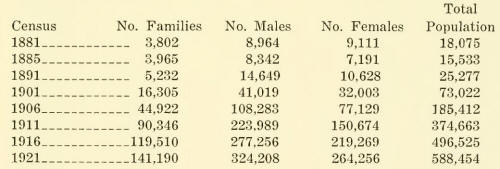
The rapid increase in the
population of Alberta is due principally to immigration. According to
the census of 1916 there were only 125,603 persons resident in the
Province at that date who were born in the Province. Since the formation
of the Province, Alberta has drawn a larger immigration than any of the
other Prairie Provinces, as the following returns will indicate:
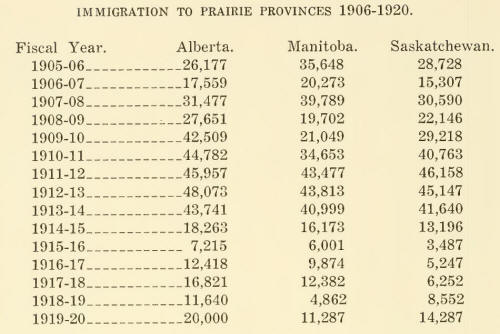
Fears have been expressed
at various times by men of affairs and publicists that there is a danger
of foreign immigration swamping the native born and destroying the
distinctive character of Canadian laws and institutions. Up to the
present time such fears are groundless. There is enough Anglo-Saxon
blood in Alberta to dilute the foreign blood and complete the process of
assimilation to the mutual advantage of both elements. The census of
1916 and the census of 1921 show in a general way the ethnological
groups that are fusing to produce a rich and virile nationality in
Alberta, as is true throughout the entire West.
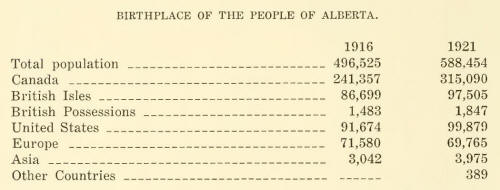
The distribution of the
population in rural and urban communities shows that the cities are
growing relatively faster than the rural areas as the subjoined table
will show:
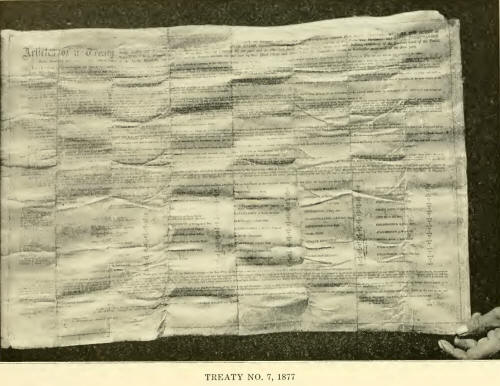

The Principal religions
are shown in the following table. The census of 1921 showed 64 distinct
religions besides 1,615 persons belonging to unspecified sects. The
Presbyterians stand first with 120,868 members and adherents. Then
follow in order Anglicans, 98,395; Roman Catholics, 97,178; Methodists,
89,070; Lutherans, 60,573; Greek Church, 35,815; Baptists, 27,829;
Mormons, 11,373.
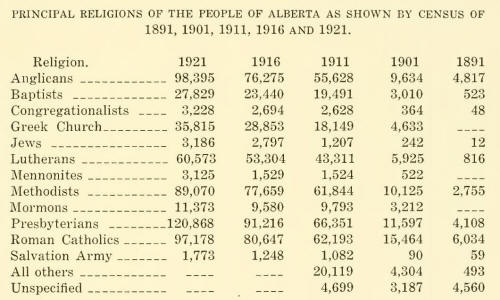 |

